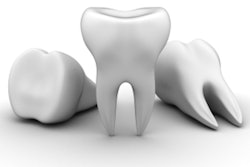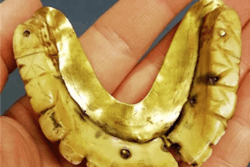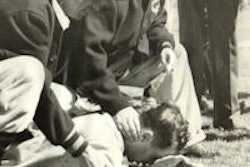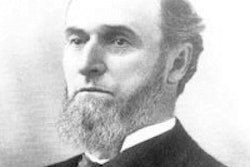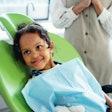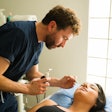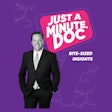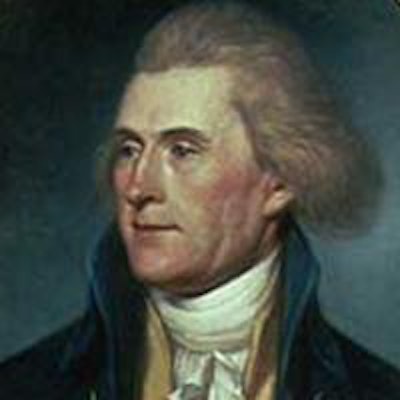
In 1808, Frances Few, an acquaintance of the then 65-year-old Thomas Jefferson, wrote that the president was a "tall thin man very dignified in his appearance." She particularly noted "his teeth are good he shews [sic] but little of them when he laughs."
Jefferson, while best known for his contribution to the writing of the Declaration of Independence and for effectively doubling the size of the U.S. with the Louisiana Purchase, was a prodigious reader and writer and accomplished in many disciplines. President John F. Kennedy paid the following tribute to his predecessor at a 1962 White House dinner honoring Noble Prize winners from the Western Hemisphere: "I think this is the most extraordinary collection of talent, of human knowledge, that has ever been gathered together at the White House, with the possible exception of when Thomas Jefferson dined alone."
 Portrait of Thomas Jefferson by Charles Willson Peale, 1791.
Portrait of Thomas Jefferson by Charles Willson Peale, 1791.
In 1824, describing the then 81-year-old Jefferson, Daniel Webster wrote, "His mouth is well formed and still filled with teeth; it is strongly compressed, bearing an expression of contentment and benevolence." That same year Jefferson wrote to Charles Willson Peale stating, "I am particularly happy not needing your porcelain teeth. I have lost only one [tooth] by age, the rest continuing sound." Peale and Jefferson had been friends for years -- both part of the intellectual elite of the time. Like Jefferson, Peale was a renaissance man of many arts, trades, and interests, one of which was the development and refinement of porcelain artificial teeth, which were replacing ivory, animal, and human teeth for dentures.
Jefferson was fastidious about his health. Documents that have survived, mostly archived at the Library of Congress, reflect his dental care. His journals list eight dental visits between 1772 at age 29 and 1824 at age 81. Whether all were for himself is unknown. Other dental needs he noted in his journals and letters included the purchase of toothpicks and toothbrushes, the latter with "the hair neither too strong nor too weak, without spunges [sic]."
In the late 1770s through the 1800s, pig, horse, and badger hair were used for bristles on toothbrushes. Another common method of teeth cleaning in the era was placing soot and salt on a rag or sponge and rubbing it on the teeth. Jefferson also recorded the purchase of "a silver toothpick case, the smallest possible," in 1785 while he was minister to France.
Jefferson experienced only two serious dental problems in his life that are known. In December 1807 at age 64, he wrote his daughter Martha: "I was taken with a toothache about five days ago, which brought on a very large and hard swelling of the face, and that produced a fever which left me last night." The swelling had subsided, but he was unsure if "it will terminate with suppuration." Seven days later, he wrote another letter to Martha in which he disclosed "the swelling abated through the whole face, but still remains in a knot as big as a pigeon's egg, over the diseased tooth, which has now been suppurating so long that the Doctor thinks he shall have to extract the tooth (altho' perfectly sound) to prevent a caries of the bone."
“His teeth are good he shews but little of them when he laughs.”
Jefferson, 1808
A week later in a letter to his granddaughter Ellen, he wrote that he had "a hard swelling still on the jawbone," but did not reveal whether or not the tooth had been pulled -- suggesting it had not. In yet another letter to his granddaughter six weeks later: "A small knot remains on the bone," which "enlarged considerably" when he went riding "on a raw day," but it "reduced to a small size" when he confined himself to the warmth of his home.
In November 1808, 11 months after he disclosed his problem in his letters to his daughter and granddaughter, there is a journal entry in which he discloses he borrowed $5 to pay "Dr. Bruff extracting, a tooth." A week later in December 1808, he wrote yet another letter to Martha: "I have been confined to the house these three weeks with a swelled face." He stated that he "suffered much" for four or five days, but "was relieved by a suppuration and have since been able to extract the tooth."
There are no further mentions of teeth or dental problems after the 1808 letter, other than his 1824 claim to Dr. Peale.
Aside from his obvious genius, Jefferson cared for and took care of his health throughout his life. He did not use any tobacco. According to Dr. John Bumgarner in his book The Health of the Presidents, "Jefferson encouraged exercise," with walking, horseback riding, and shooting as his favorite forms of exercise.
According to Monticello.org, "walking was his preferred exercise." While minister to France, he walked 1.2 miles every day, which he recorded he did in "double steps" and which took him on average "17½ minutes." He advocated two hours of exercise a day, and he never took a book with him because he said, "The object of walking is to relax the mind." He wrote: "A strong body makes a mind strong." But he discouraged "games played with the ball and others of that nature" because they "are too violent for the body."
Dr. Bumgarner also discloses that Jefferson drank three glasses of "weak" wine every day. He did not drink "ardent" wine or any "ardent" spirits. He enjoyed "malt liquers [sic] and ciders," as his "table drink." Dr. Bumgarner's research shows that Jefferson wrote that he "ate little animal meat" in an 1819 letter to a physician. "Vegetables were his principle diet," he noted. Jefferson apparently believed one of the reasons he led such a relatively healthy life was his habit of placing his feet in a bucket of cold water every morning when he got out of bed.
Jefferson was born in 1743, the third of 10 children. His political career began when he was elected to the Virginia House of Burgesses in 1769. In 1775, he was a delegate to the Second Continental Congress in Philadelphia. During that congress, he was the principal author of the Declaration of Independence. He returned to Virginia, where in 1779 he was elected governor of Virginia, a position which he held for two years. In 1783, he was appointed a delegate to the Confederation Congress and in 1785 was appointed minister to France -- a position he held until 1789. That same year he was appointed secretary of state.
In 1796, Jefferson ran for president but was defeated by John Adams. Having the second most electoral votes, however, Jefferson became vice president. In 1800, he was elected as the third U.S. president, the office in which he served for two terms, from 1801 to 1809. He died on July 4, 1826, at the age of 83.
Daniel Demers is a semiretired businessman whose hobby is researching and writing about 19th and 20th century historical events and personalities. He holds a bachelor's degree in history from George Washington University and a master's degree in business from Chapman University. You can review his other published works at www.danieldemers.com.
Sources
Books
Thorpe BL. Charles Willson Peale. In: Koch CRE, ed. History of Dental Surgery: Biographies of Pioneer American Dentists and Their Successors. Vol. 3. Akron, OH: National Art Publishing Company; 1910:36-48.
Articles
Health and medical history of President Thomas Jefferson. Dr. Zebra.com. https://doctorzebra.com/prez/g03.htm. Accessed April 5, 2014.
Katz H. Famous smiles: U.S. presidential edition. TheraBreath.com. https://www.therabreath.com/articles/blog/fresh-breath-happenings/famous-smiles-us-presidential-edition-33054.asp. Accessed April 5, 2014.
Kennedy JF. Remarks at a dinner honoring Nobel Prize winners of the Western Hemisphere. April 29, 1962. Online by Peters G, Woolley JT. The American Presidency Project. http://www.presidency.ucsb.edu/ws/?pid=8623. Accessed April 9, 2014.
Physical descriptions of Thomas Jefferson. Thomas Jefferson's Monticello website. https://www.monticello.org/research-education/thomas-jefferson-encyclopedia/physical-descriptions-jefferson/. Accessed April 4, 2014.
Exercise.Thomas Jefferson's Monticello website. https://www.monticello.org/research-education/thomas-jefferson-encyclopedia/exercise/. Accessed April 9, 2014.
Teeth. Thomas Jefferson's Monticello website. https://www.monticello.org/research-education/thomas-jefferson-encyclopedia/teeth/. Accessed April 5, 2014.
Websites
Thomas Jefferson. Wikipedia website. https://en.wikipedia.org/wiki/Thomas_Jefferson. Accessed April 7, 2014.
Toothbrush. Wikipedia website. https://en.wikipedia.org/wiki/Toothbrush#History. Accessed April 8, 2014.
Anna Berks, research librarian, Jefferson Library, Monticello.org.




